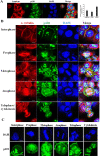Nuclear p120 catenin is a component of the perichromosomal layer and coordinates sister chromatid segregation during mitosis in lung cancer cells
- PMID: 35660718
- PMCID: PMC9167299
- DOI: 10.1038/s41419-022-04929-z
Nuclear p120 catenin is a component of the perichromosomal layer and coordinates sister chromatid segregation during mitosis in lung cancer cells
Abstract
Abnormal expression of p120 catenin is associated with the malignant phenotype in human lung cancer. Numerous studies have focused on the function of p120 catenin in the juxta-membrane compartment. However, the role of nuclear p120 catenin remains unclear. In this study, the dynamic changes in nuclear p120 catenin localization during cell cycle progression were investigated. Immunofluorescent staining, FACS analysis, and western blotting revealed that nuclear p120 catenin is a major architectural constituent of the chromosome periphery during mitosis. During mitosis, granule-like p120 catenin dispersed into a cloudy-like structure and formed cordon-like structures surrounding the condensed chromosomes to create the peri-chromosomal layer. Interestingly, lumican and p120 catenin colocalized at the spindle fiber where the perichromosomal layer connects to the condensed chromosomes during mitosis. Furthermore, downregulation of p120 catenin using a specific siRNA induced cell cycle stalling in the G2/M phase and promoted aneuploidy. This study validates the role of nuclear p120 catenin in the formation of the chromosome periphery and reveals the p120 catenin-lumican interaction may couple orientation of cell division with the segregation of sister chromatids during mitosis. Our data suggest the protective role of p120 catenin in maintaining the integrity of chromosomes, and also warrants further studies to evaluate the contribution of the loss of p120 catenin to the creation of gene rearrangement in cancer evolution and tumor progression.
© 2022. The Author(s).
Conflict of interest statement
The authors declare no competing interests.
Figures





References
-
- Petersen I. Chromosomes, ploidy and differentiation of lung cancer. Cancer Res. 2004;64(7 Suppl):238.
Publication types
MeSH terms
Substances
LinkOut - more resources
Full Text Sources
Medical

